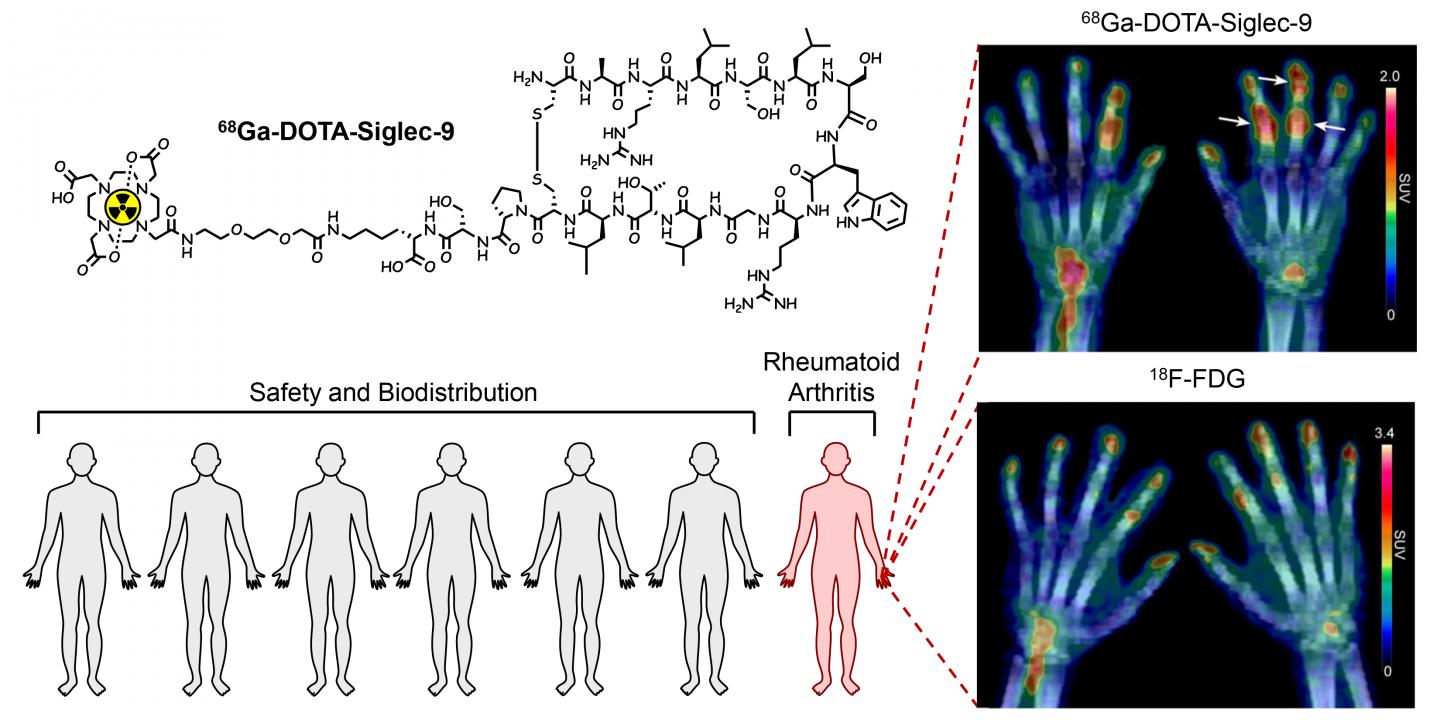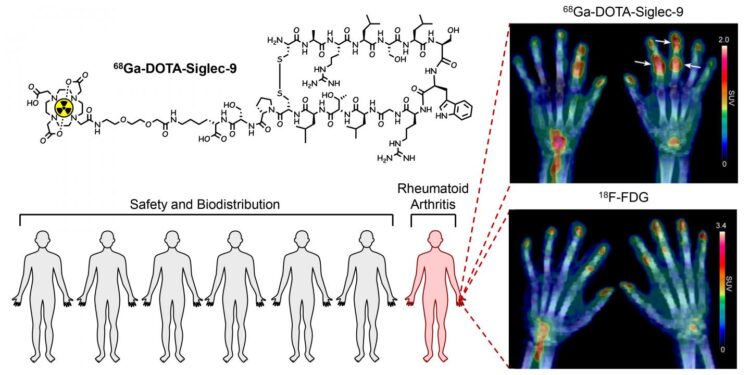
Credit: Image created by Olli Moisio, MSc, and Riikka Viitanen, PhD, Turku PET Centre.
Reston, VA–New research shows that a novel positron emission tomography (PET) tracer that targets inflammation is safe and can clearly identify early stages of rheumatoid arthritis. The promising PET tracer, 68Ga-DOTA-Siglec-9, rapidly clears from blood circulation, has a low radiation dose, and can be easily produced. This first-in-human study was published in the April issue of the Journal of Nuclear Medicine.
Inflammation is a significant part of several chronic diseases, including rheumatoid arthritis and its related issues. While PET imaging with 18F-FDG is a valuable tool for the diagnosis and monitoring of the effects of treatments, it is not specific enough to assess inflammation.
“It’s important to detect inflammation early so that patients can receive the best treatment,” said Anne Roivainen, PhD, professor of preclinical imaging and drug research at Turku PET Centre at the University of Turku and Turku University Hospital in Finland. “Our institution has worked for several years to develop an imaging agent that targets areas of inflammation, and in this study, tested its effectiveness in humans for the first time.”
To evaluate the radiotracer’s safety and biodistribution characteristics, six healthy study participants underwent whole body 68Ga-DOTA-Siglec-9 PET/computed tomography scans. 68Ga-DOTA-Siglec-9 was well-tolerated and cleared quickly from the blood, and its radiation dose was similar to other 68Ga tracers. In one additional study participant with rheumatoid arthritis, the tracer was able to clearly detect joints with arthritis.
“We have proven that the characteristics of 68Ga-DOTA-Siglec-9 are favorable for use in patient imaging studies,” remarked Roivainen. “Future studies will clarify whether 68Ga-DOTA-Siglec-9 PET imaging has the potential to detect other inflammatory diseases early. It could also help to evaluate the effectiveness of treatments and promptly identify patients who are unlikely respond to therapy.”
This study was made available online in August 2020 ahead of final publication in print in April 2021.
###
The authors of “First-in-Humans Study of 68Ga-DOTA-Siglec-9, a PET Ligand Targeting Vascular Adhesion Protein 1” include Riikka Viitanen, Olli Moisio, Xiang-Guo Li, Vesa Oikonen and Helena Virtanen, Turku PET Centre, University of Turku, Turku, Finland; Petteri Lankinen, Department of Orthopaedics and Traumatology, Turku University Hospital and University of Turku, Turku, Finland, and Turku PET Centre, Turku University Hospital, Turku, Finland; Mikko Koivumäki, Turku PET Centre, Turku University Hospital, Turku, Finland; Sami Suilamo, Department of Medical Physics, Turku University Hospital, Turku, Finland, and Department of Oncology and Radiotherapy, Turku University Hospital, Turku, Finland; Tula Tolvanen, Turku PET Centre, Turku University Hospital, Turku, Finland, and Department of Medical Physics, Turku University Hospital, Turku, Finland; Kirsi Taimen, Markku Mali, Ilpo Koskivirta and Laura Pirilä, Department of Rheumatology and Clinical Immunology, Division of Medicine, Turku University Hospital, Turku, Finland; Ia Kohonen, Department of Radiology, Turku University Hospital, Turku, Finland; Kristiina Santalahti and Sirpa Jalkanen, MediCity Research Laboratory, University of Turku, Turku, Finland; Anu Autio, Turku PET Centre, University of Turku, Turku, Finland, and MediCity Research Laboratory, University of Turku, Turku, Finland; Antti Saraste, Turku PET Centre, University of Turku, Turku, Finland, Turku PET Centre, Turku University Hospital, Turku, Finland, and Heart Center, Turku University Hospital, Turku, Finland; Pirjo Nuutila, Juhani Knuuti and Anne Roivainen, Turku PET Centre, University of Turku, Turku, Finland, and Turku PET Centre, Turku University Hospital, Turku, Finland.
Visit JNM’s new website for the latest research in nuclear medicine and molecular imaging. To schedule an interview with the researchers, please contact Rebecca Maxey at (703) 652-6772 or [email protected]
About JNM and the Society of Nuclear Medicine and Molecular Imaging
The Journal of Nuclear Medicine (JNM) is the world’s leading nuclear medicine, molecular imaging and theranostics journal, accessed more than 11 million times each year by practitioners around the globe, providing them with the information they need to advance this rapidly expanding field. Current and past issues of the Journal of Nuclear Medicine can be found online at http://jnm.
JNM is published by the Society of Nuclear Medicine and Molecular Imaging (SNMMI), an international scientific and medical organization dedicated to advancing nuclear medicine and molecular imaging–precision medicine that allows diagnosis and treatment to be tailored to individual patients in order to achieve the best possible outcomes. For more information, visit http://www.
Media Contact
Rebecca Maxey
[email protected]
Original Source
http://www.
Related Journal Article
http://dx.





